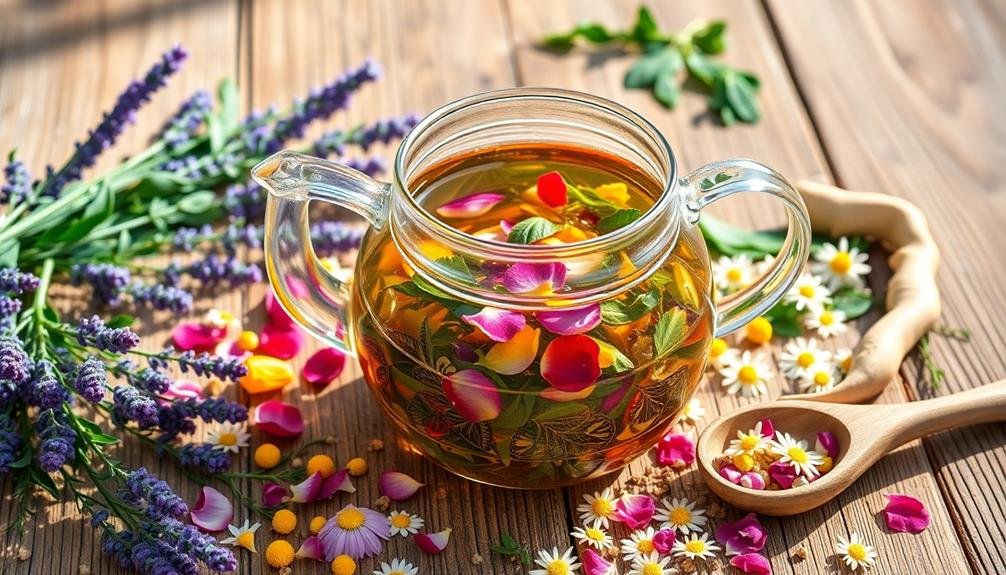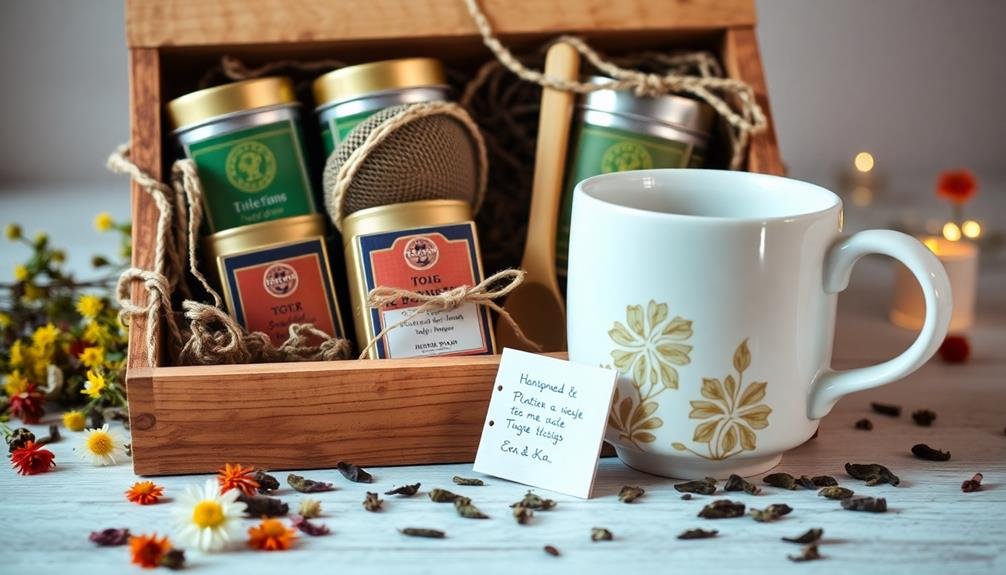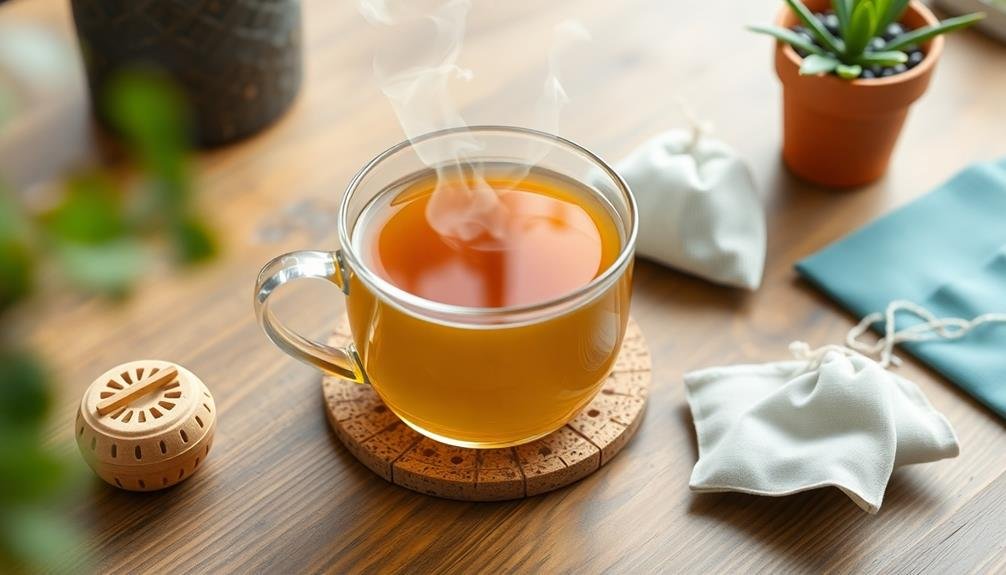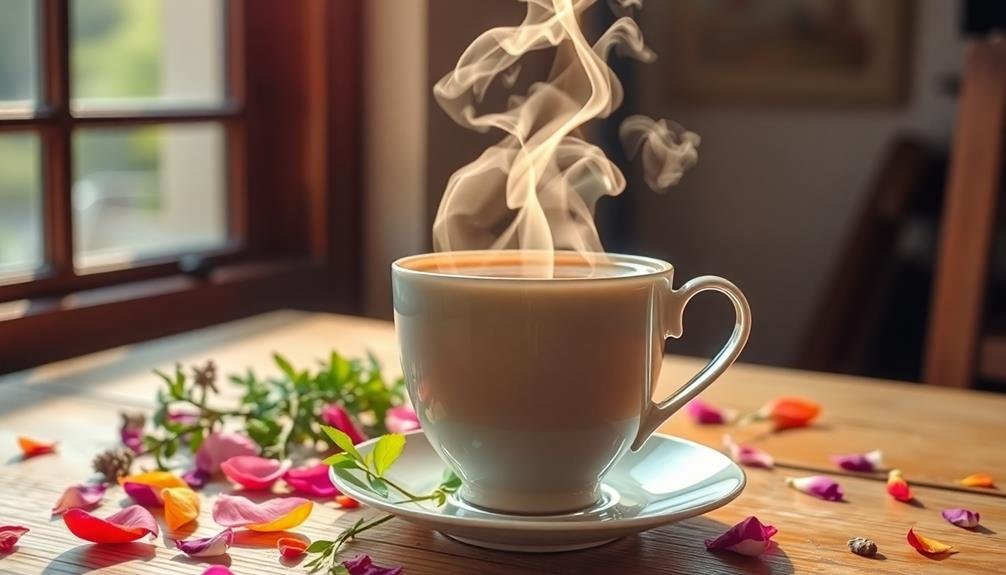To master herbal tea blending, you'll need to understand the perfect ratios. Start with base herbs, which make up 50-80% of your blend. Combine complementary flavors like sweet and spicy or floral and citrus, adjusting ratios to achieve the desired profile. For therapeutic blends, use a 3:2:1 ratio of primary, secondary, and complementary herbs. Consider seasonal ingredients and experiment with unique additions like edible flowers or spices. Enhance aroma and mouthfeel by using fragrant herbs and natural oils. Remember, the key to perfect blending lies in balancing dominant and supporting flavors. Reveal the secrets of herbal tea artistry and elevate your brewing skills.
Understanding Base Herbs

When crafting herbal tea blends, understanding base herbs is essential. These foundational ingredients form the bulk of your blend, typically making up 50-80% of the mixture. Base herbs provide the primary flavor, aroma, and therapeutic benefits of your tea. Common base herbs include chamomile, peppermint, rooibos, and green tea.
To choose the right base herb, consider its flavor profile, health benefits, and how it complements other ingredients. Chamomile offers a sweet, apple-like taste and calming properties, while peppermint provides a cool, invigorating flavor and aids digestion. Rooibos brings a nutty, slightly sweet taste and is rich in antioxidants. Green tea offers a grassy, vegetal flavor and boosts metabolism.
When selecting base herbs, pay attention to their strength and brewing time. Some herbs, like peppermint, can quickly overpower other flavors, while others, such as chamomile, are more subtle.
Experiment with different ratios to find the perfect balance for your blend. Remember that the base herb sets the tone for your entire tea, so choose wisely and adjust as needed.
Complementary Flavor Combinations
You'll discover a world of exciting flavors when you start combining complementary herbs in your tea blends.
Sweet and spicy pairings, like cinnamon and licorice root, can create a warming, comforting brew.
Experiment with floral and citrus blends for a revitalizing taste, or try earthy and minty combinations for a grounding yet invigorating experience.
Sweet and Spicy Pairings
Blending sweet and spicy flavors creates a delightful contrast in herbal teas, offering a complex and satisfying taste experience. You'll find that combining these elements can elevate your tea blends to new heights of flavor sophistication.
When pairing sweet and spicy ingredients, consider the intensity of each component. A mild sweetness from chamomile or licorice root can balance a fiery ginger or peppercorn. Alternatively, a bold cinnamon stick might complement the subtle sweetness of rosehips. Experiment with different ratios to find your perfect balance.
Here are some popular sweet and spicy pairings to inspire your blending:
| Sweet Ingredient | Spicy Ingredient | Complementary Base |
|---|---|---|
| Honeybush | Cinnamon | Rooibos |
| Apple pieces | Ginger | Green tea |
| Stevia leaf | Pink peppercorn | Lemongrass |
Floral and Citrus Blends
Moving from sweet and spicy combinations, let's explore another exciting flavor pairing in herbal tea blending: floral and citrus. These two profiles complement each other beautifully, creating a revitalizing and balanced infusion.
Start with a base of floral herbs like chamomile, lavender, or rose petals. Then, add citrus elements such as lemon verbena, lemongrass, or dried orange peel.
For a well-rounded blend, aim for a 2:1 ratio of floral to citrus components. This balance allows the delicate floral notes to shine while the citrus adds a bright, zesty kick. Experiment with different combinations to find your perfect match.
Try pairing lavender with lemon verbena for a soothing yet invigorating cup, or mix rose petals with orange peel for a more exotic flavor profile.
Don't forget to evaluate the strength of each ingredient. Citrus elements can quickly overpower floral notes, so start with small amounts and adjust to taste.
You can also include a neutral herb like peppermint or spearmint to bridge the gap between floral and citrus flavors, creating a more complex and intriguing blend.
Earthy and Minty Combinations
Earthy and minty flavors create a grounding yet stimulating combination in herbal tea blends. You'll find that pairing herbs like peppermint or spearmint with earthy bases such as rooibos or yerba mate can yield a balanced and revitalizing brew. Start with a 2:1 ratio of earthy to minty herbs, adjusting to suit your taste preferences.
For a classic earthy-mint blend, try combining 2 parts roasted dandelion root with 1 part peppermint leaves. This combination offers a rich, coffee-like base with a cool, minty finish.
If you're looking for a more complex flavor profile, experiment with a 3:2:1 ratio of nettle leaves, peppermint, and licorice root. The nettle provides a deep, grassy note, while the licorice adds natural sweetness.
Don't overlook the power of subtle mint varieties like lemon balm or catnip. These can be combined with earthy herbs like holy basil or burdock root in equal parts for a milder, more nuanced blend.
Remember to steep earthy-minty combinations for 5-7 minutes in water just below boiling to extract the full range of flavors without bitterness.
Balancing Strength and Subtlety

When blending herbal teas, you'll need to contemplate the balance between dominant and supporting flavors.
You can create depth by layering different flavor profiles, allowing some herbs to take center stage while others provide subtle background notes.
Dominant vs. Supporting Flavors
As you explore herbal tea blending, understanding the interplay between dominant and supporting flavors becomes essential. Dominant flavors form the backbone of your blend, while supporting flavors enhance and complement the main taste.
To create a balanced and harmonious blend, you'll need to carefully select and proportion these elements. When choosing your dominant flavor, consider herbs with strong, distinctive tastes like peppermint, chamomile, or ginger. These should make up about 50-70% of your blend.
Supporting flavors, which add depth and complexity, should comprise the remaining 30-50%. These can include milder herbs, spices, or flowers that complement your dominant flavor without overpowering it.
To master the art of balancing dominant and supporting flavors:
- Experiment with different ratios
- Start with small batches to refine your blend
- Consider the strength and intensity of each ingredient
- Use complementary flavors that enhance the dominant herb
- Pay attention to how flavors change during steeping
Layering Flavor Profiles
Layering flavor profiles in herbal tea blending is an art that builds upon the concept of dominant and supporting flavors. It's about creating depth and complexity in your blend by carefully combining different herbs and botanicals to achieve a harmonious taste experience.
Start by selecting your base flavor, which will be the foundation of your blend. This could be a robust herb like peppermint or chamomile. Next, add complementary flavors that enhance and support the base. For example, if you're using chamomile as your base, you might add lemon balm for a citrusy note.
As you layer flavors, consider their intensity and how they'll interact. Stronger flavors should be used sparingly, while milder ones can be added in larger quantities. Think about the order in which flavors will hit the palate – you want a smooth progression from one taste to another.
Don't forget about aroma. Some herbs contribute more to scent than taste, so include aromatic ingredients to create a multi-sensory experience.
Experiment with different ratios and combinations until you achieve the perfect balance of strength and subtlety in your herbal tea blend.
Ratios for Therapeutic Blends
Creating therapeutic herbal tea blends involves more than just mixing your favorite herbs together.
You'll need to take into account the specific health benefits you're targeting and the potency of each herb. A general rule of thumb is to use a 3:2:1 ratio for your primary, secondary, and complementary herbs. This means 3 parts of your main therapeutic herb, 2 parts of a supporting herb, and 1 part of a flavor-enhancing or synergistic herb.
For example, if you're crafting a blend for relaxation, you might use:
- 3 parts chamomile (primary calming herb)
- 2 parts lemon balm (supporting relaxant)
- 1 part lavender (complementary and aromatic)
Seasonal Blending Considerations

Seasonal tea blending offers a unique opportunity to harmonize with nature's rhythms. As you craft your herbal blends, consider the changing seasons and how they affect both your body and the availability of herbs. In spring, focus on detoxifying and energizing blends to shake off winter's lethargy. Summer calls for cooling and hydrating teas to combat heat and support outdoor activities. Fall blends should boost immunity and provide comfort as temperatures drop. Winter teas can warm the body and support respiratory health.
When selecting herbs for each season, consider their peak harvest times and therapeutic properties. Here's a quick guide to seasonal blending:
| Season | Key Herbs | Blend Focus |
|---|---|---|
| Spring | Dandelion, Nettle, Mint | Cleansing, Renewal |
| Summer | Hibiscus, Lemongrass, Chamomile | Cooling, Invigorating |
| Fall | Elderberry, Echinacea, Ginger | Immune Support, Warming |
Adjust your blending ratios to emphasize seasonal herbs while maintaining a balanced flavor profile. Don't forget to incorporate local, seasonal ingredients when possible to enhance freshness and connect with your environment. By aligning your tea blends with the seasons, you'll create more effective and enjoyable herbal infusions year-round.
Enhancing Aroma and Mouthfeel
Elevate your herbal tea blends by focusing on aroma and mouthfeel, two essential aspects that can transform a simple infusion into a sensory experience.
To enhance aroma, consider adding fragrant herbs like lavender, lemon balm, or rose petals. These not only contribute to the scent but also influence the overall taste profile.
For a fuller mouthfeel, incorporate ingredients with natural oils, such as peppermint or lemongrass.
Experiment with different techniques to boost your blend's sensory appeal:
- Use a mortar and pestle to lightly crush herbs, releasing more aromatic oils
- Add a pinch of licorice root for natural sweetness and a silky texture
- Include small amounts of marshmallow root for a smooth, creamy mouthfeel
- Incorporate dried citrus peels for a zesty aroma and slight bitterness
- Blend in roasted dandelion root for depth and a coffee-like richness
Experimenting With Unique Ingredients

Ready to take your herbal tea blends to the next level? It's time to explore unique ingredients that'll set your creations apart. Start by considering unconventional herbs like lemon verbena, tulsi, or schisandra berries. These lesser-known botanicals can add depth and complexity to your blends.
Don't limit yourself to herbs; experiment with spices like cardamom, star anise, or pink peppercorns. These can introduce unexpected flavors and aromas.
Try incorporating dried fruits like goji berries, mulberries, or apple pieces for natural sweetness and added nutrition. Edible flowers such as lavender, rose petals, or chrysanthemum can impart delicate flavors and visual appeal.
For an earthy twist, consider adding small amounts of roots like burdock or licorice root. When experimenting, start with small batches and keep detailed notes on your combinations.
Use a ratio of 1-2 teaspoons of your unique ingredient per cup of base herbs. Remember to research any potential contraindications or allergies associated with new ingredients.
As you discover successful blends, gradually increase the proportion of unique elements to create truly distinctive teas that showcase your creativity and palate.
Frequently Asked Questions
How Long Can Herbal Tea Blends Be Stored Before Losing Potency?
You'll find that properly stored herbal tea blends can retain potency for 6-12 months. Keep them in airtight containers away from light, heat, and moisture. After a year, you'll notice a gradual loss in flavor and effectiveness.
Are There Any Herbs That Should Never Be Mixed Together?
You should avoid mixing certain herbs together. Don't combine St. John's Wort with antidepressants, or licorice root with blood pressure medications. Be cautious with combining sedative herbs like valerian and kava. Always consult a healthcare professional before mixing herbs.
Can I Use Fresh Herbs Instead of Dried Ones in Tea Blends?
Yes, you can use fresh herbs in tea blends. They'll provide a more vibrant flavor, but you'll need to use more. Remember, fresh herbs contain water, so adjust your ratios accordingly. Experiment to find your perfect blend.
What's the Best Way to Measure Herbs for Consistent Blending Results?
To measure herbs consistently, you'll want to use a digital scale for accuracy. Stick to weight measurements like grams or ounces rather than volume. This guarantees your blends are precise and repeatable every time you make them.
How Do I Adjust Blend Ratios for Cold-Brewed Versus Hot-Brewed Herbal Teas?
You'll want to use more herbs for cold-brewed teas, as they extract slower. Double your usual hot-brew ratios. For hot-brewed teas, stick to standard measurements. Adjust steeping times accordingly for ideal flavor in both methods.
In Summary
You've now revealed the secrets to creating perfect herbal tea blends. Armed with knowledge of base herbs, flavor pairings, and ideal ratios, you're ready to craft your own signature blends. Don't forget to contemplate therapeutic benefits, seasonal ingredients, and sensory elements. As you experiment, you'll develop an intuitive sense for balancing flavors and strengths. Keep exploring new ingredients and combinations – your perfect cup of herbal tea awaits!





Leave a Reply